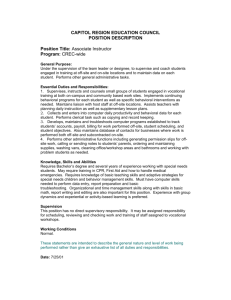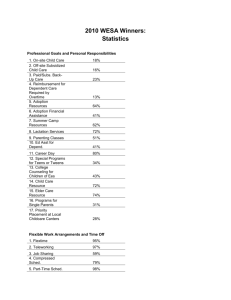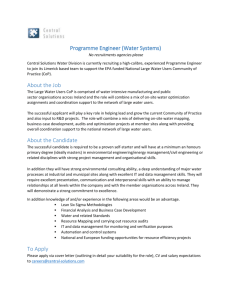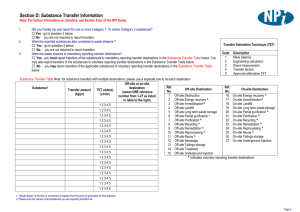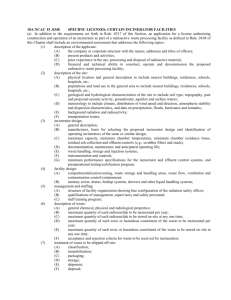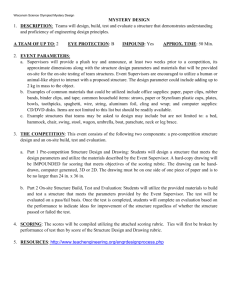Schedule 11 Energy Source Data Requirements
advertisement
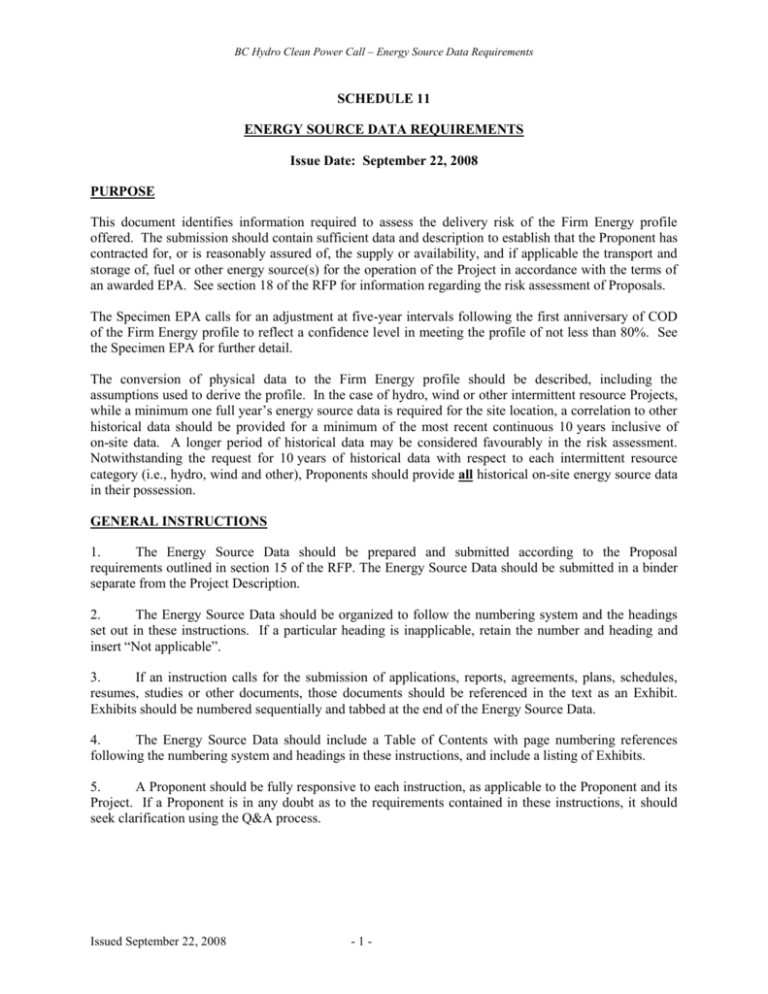
BC Hydro Clean Power Call – Energy Source Data Requirements SCHEDULE 11 ENERGY SOURCE DATA REQUIREMENTS Issue Date: September 22, 2008 PURPOSE This document identifies information required to assess the delivery risk of the Firm Energy profile offered. The submission should contain sufficient data and description to establish that the Proponent has contracted for, or is reasonably assured of, the supply or availability, and if applicable the transport and storage of, fuel or other energy source(s) for the operation of the Project in accordance with the terms of an awarded EPA. See section 18 of the RFP for information regarding the risk assessment of Proposals. The Specimen EPA calls for an adjustment at five-year intervals following the first anniversary of COD of the Firm Energy profile to reflect a confidence level in meeting the profile of not less than 80%. See the Specimen EPA for further detail. The conversion of physical data to the Firm Energy profile should be described, including the assumptions used to derive the profile. In the case of hydro, wind or other intermittent resource Projects, while a minimum one full year’s energy source data is required for the site location, a correlation to other historical data should be provided for a minimum of the most recent continuous 10 years inclusive of on-site data. A longer period of historical data may be considered favourably in the risk assessment. Notwithstanding the request for 10 years of historical data with respect to each intermittent resource category (i.e., hydro, wind and other), Proponents should provide all historical on-site energy source data in their possession. GENERAL INSTRUCTIONS 1. The Energy Source Data should be prepared and submitted according to the Proposal requirements outlined in section 15 of the RFP. The Energy Source Data should be submitted in a binder separate from the Project Description. 2. The Energy Source Data should be organized to follow the numbering system and the headings set out in these instructions. If a particular heading is inapplicable, retain the number and heading and insert “Not applicable”. 3. If an instruction calls for the submission of applications, reports, agreements, plans, schedules, resumes, studies or other documents, those documents should be referenced in the text as an Exhibit. Exhibits should be numbered sequentially and tabbed at the end of the Energy Source Data. 4. The Energy Source Data should include a Table of Contents with page numbering references following the numbering system and headings in these instructions, and include a listing of Exhibits. 5. A Proponent should be fully responsive to each instruction, as applicable to the Proponent and its Project. If a Proponent is in any doubt as to the requirements contained in these instructions, it should seek clarification using the Q&A process. Issued September 22, 2008 -1- BC Hydro Clean Power Call – Energy Source Data Requirements ENERGY SOURCE DATA INSTRUCTIONS A. B. Hydrological Data: (a) Describe the stream flows based on at least one year of on-site average daily flows (or more frequent, if available) historical data. (b) Describe the method of estimating the long-term energy source characteristics of the site. If on-site data beyond the one-year daily average flow on-site requirement is not available, Proponents may estimate the expected flow data, based on the most recent years of correlated flow data from another representative off-site location. At least 10 years of correlated data should be provided, with at least one year of overlap between the on-site data and the off-site data, including the degree of correlation between the on-site data and the off-site data. If an off-site record is used, provide details of the correlation or other study method, and describe how the method raised or lowered the estimate based on on-site data alone. (c) Include the number, type and characteristics of proposed or existing turbines including: (i) efficiency curves identifying the minimum, maximum and most efficient power output, and (ii) the corresponding turbine discharges. The relationship between head, flow and efficiency should be demonstrated. (d) Describe how the total generation estimate (as provided through the Firm Energy profile and estimated Non-Firm Energy profile offered in the Commercial Proposal) is determined by reference to the historical energy source data and turbine and generator characteristics. (e) Provide an estimate of energy generation (in MWh) from the Project that could have been generated based on historical data in item (b), for each of the most recent 10 years of historical energy source data, in a resolution comparable to that used in the Firm Energy profile (hourly or seasonally) contained in the Commercial Proposal. (f) Describe the storage capabilities, if any, of the Project. For a Project employing a reservoir, provide a physical description of the reservoir, and storage and elevation curves/tables, and its expected operation. Indicate any known or anticipated constraints on the reservoir elevation and operation, including minimum and maximum elevations. (g) Describe any known or likely physical or legal (e.g., permit) flow constraints that would affect overall water availability or constrain generation operations, such as minimum turbine releases or ramping rates, or minimum environmental release. (h) Describe any operational synergies between the Project and other generation facilities. Wind Data: (a) Provide at least one year of raw hourly or 10 minute on-site historical data that has been used for the wind resource assessment of the site. (b) Provide a table detailing the measurements at each on-site monitoring station. Include the dates of commissioning and decommissioning, the period of record used for the wind resource assessment, the location in latitude/longitude or UTM co-ordinates, a description Issued September 22, 2008 -2- BC Hydro Clean Power Call – Energy Source Data Requirements of the equipment used to record data, and the type, height, orientation and mounting method for all sensors. Include a summary of maintenance records for each monitoring station. (c) Provide a table showing monthly data recovery rates and measured means for all monitoring stations employed in the assessment. (d) Describe the methodology employed to extrapolate wind speeds at measurement height to hub height (where applicable). (e) Describe the method of estimating the long-term wind speed characteristics of the site. If on-site data beyond the one-year on-site requirement is not available, Proponents may estimate the expected wind speed data, based on the most recent years of correlated wind speed data from another representative off-site location. At least 10 years of correlated data should be provided, with at least one year of overlap between the on-site data and the off-site data, including the degree of correlation between the on-site data and the offsite data. If an off-site record is used, provide (i) the raw wind speed and direction data of the reference station used to adjust the measured on-site wind speeds to the long-term, and (ii) details of the correlation or other study method, and describe how the method raised or lowered the estimate based on on-site data alone. (f) For each on-site monitoring station used in the wind resource assessment, provide a table showing the wind speed and directional frequency distribution on a seasonal basis. (g) Provide the make and model, rotor diameter, hub height and power curve of all proposed turbines. Indicate the status of the turbine vendor review of the site plan. (h) Provide a detailed topographic map of the Project area showing the locations of all on-site monitoring stations used for the wind resource assessment and the locations of all proposed turbines. Include a list of the turbine locations, using latitude/longitude or UTM co-ordinates. (i) Describe the methodology employed to predict wind speed variations across the site. Include details of the wind flow modeling employed and any inputs to the model (where applicable). (j) Describe the methodology employed to estimate the energy yield for the site. Include the predicted long-term on-site air density, the turbine power curve employed, a description of any adjustments made to the power curve and a table quantifying the energy loss factors used to adjust the gross energy estimate to the net energy estimate. Loss factors should include the following: Topographic adjustments Array (wake) losses Electrical losses between the turbines and the point of metering (e.g., on the low side of the project transformer, or the POI) Turbine availability Icing and blade degradation High wind hysteresis Substation and infrastructure maintenance Power curve adjustment Issued September 22, 2008 -3- BC Hydro Clean Power Call – Energy Source Data Requirements (k) Wind sector management Utility system downtime. Provide estimates (expected P50, P70, P75, P80, P85, P90) of net energy generation (in MWh) from the Project for a typical year for each period (hourly or seasonally, using the same format as the Firm Energy profile offered in the Commercial Proposal). C. Other Technologies: C.1 For combustible fuels: C.2 (a) Describe the fuel and its source(s). (b) Describe the Proponent’s plan to procure and transport the fuel, as applicable, in sufficient quantities to operate the Project in accordance with the terms of an awarded EPA. (c) Provide as an Exhibit to the Energy Source Data copies of any preliminary or final agreements or commitments in implementation of the Proponent’s fuel plan. (d) Describe any infrastructure necessary to procure, process, transport, receive, store and handle any fuel required for the Project, including the development status of such improvements, identification of any permits or approvals required for such improvements, the schedule for completion of such improvements, and any known or expected obstacles for the development and construction of such improvements. (e) Describe the volume of on-site, or local, storage for fuel that is included in the Project design. (f) Provide the number, type and characteristics of proposed or existing turbines including fuel-to-energy conversion factors (e.g., design heat rate curve(s)). (g) Describe how the total generation estimate (as provided through the Firm Energy profile and estimated Non-Firm Energy profile offered in the Commercial Proposal) is determined by reference to the historical energy source data. For other intermittent energy sources (not hydro or wind): (a) Describe the availability of the energy source, based on at least one year of on-site average daily historical data (or more frequent, if available). (b) Describe the method of estimating the long-term energy source characteristics of the site. If on-site data beyond the one-year daily average on-site requirement is not available, Proponents may estimate the expected energy source data, based on the most recent years of correlated energy source data from another representative off-site location. At least 10 years of correlated data should be provided, with at least one year of overlap between the on-site data and the off-site data, including the degree of correlation between the on-site data and the off-site data. If an off-site record is used, provide details of the correlation Issued September 22, 2008 -4- BC Hydro Clean Power Call – Energy Source Data Requirements or other study method and describe how the method raised or lowered the estimate based on on-site data alone. (c) Include the number, type and characteristics of proposed or existing turbines, including efficiency curves identifying the minimum, maximum and most efficient power output. (d) Describe how the total generation estimate (as provided through the Firm Energy profile and estimated Non-Firm Energy profile offered in the Commercial Proposal) is determined by reference to the historical energy source data and generator characteristics. (e) Provide an estimate of energy generation (in MWh) from the Project that could have been generated based on historical data in item (b), for each of the most recent 10 years of historical energy source data in a resolution comparable to that used in the Firm Energy profile (hourly or seasonally) contained in the Commercial Proposal. Issued September 22, 2008 -5-
